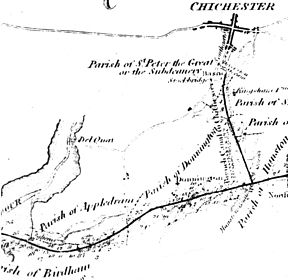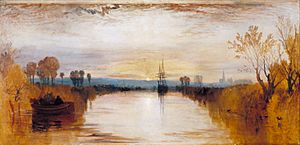Chichester Canal facts for kids
Quick facts for kids Chichester Canal |
|
|---|---|

A map of the planned route of the canal from 1815
|
|
| Specifications | |
| Maximum boat length | 85 ft 0 in (25.91 m) |
| Maximum boat beam | 18 ft 0 in (5.49 m) |
| Locks | 2 |
| Status | part navigable |
| Navigation authority | West Sussex County Council |
| History | |
| Date of act | 1819 |
| Date of first use | 1822 |
| Date closed | 1928 |
| Date restored | 1984 |
| Geography | |
| Start point | Chichester |
| End point | Chichester Harbour |
The Chichester Canal is a waterway in England. It is mostly open for boats, except for a part in the middle. The canal is about 3.8 miles (6.1 km) long. It stretches from the city of Chichester to Chichester Harbour at Birdham. Along its path, it has two special gates called locks.
The canal was originally part of a bigger project called the Portsmouth and Arundel Canal. It opened in 1822 and took three years to build. The canal was designed to carry large boats. These boats could weigh up to 100 tons. They could be up to 85 feet (26 meters) long and 18 feet (5.5 meters) wide. The water in the canal was deep enough for boats with a draft of up to 7 feet (2.1 meters).
When workers were digging the Chichester Basin in the 1820s, they found something amazing. They unearthed a hidden treasure of 300 ancient Roman coins called Denarii. This was a cool discovery because Chichester was once a Roman settlement.
Contents
History of the Chichester Canal
Building the Canal
People had ideas for a canal linking Chichester to the sea a long time ago. The first idea was in 1585, when a special law was passed to allow it. More plans were made in the early 1800s, but none of them happened.
Finally, in 1817, a decision was made. The section of the canal near Chichester would be built extra large. This was so it could carry very big boats, up to 100 tons. A new law was needed for this, and it was approved in 1819. Building the Chichester part of the canal started in the same year.
As mentioned, during the digging of the basin, a collection of 300 Roman coins was found. The Chichester Canal officially opened on April 9, 1822.
The larger Portsmouth and Arundel Canal was planned to create a safe inland route from London to Portsmouth. This was important during a war with France. However, by the time the canal was finished, the war had ended. Because of this, the canal was not very successful for business. Most of it stopped being used by 1847, but the Chichester section kept going.
Later Years and Changes
In 1892, the canal was given to the city council of Chichester, known as the Corporation of Chichester. The canal needed a lot of repairs. This included fixing the locks and bridges, and clearing out weeds and mud.
By 1898, only a small amount of goods were being carried on the canal. The last time commercial boats used the canal was in 1906. They carried a load of small stones from the harbour to the basin. Around this time, some of the bridges needed fixing or replacing. Local councils wanted to put in fixed bridges, which would have blocked the canal. But the Corporation of Chichester wanted to keep it open for boats. By 1923, the city council agreed to fixed bridges, as there wasn't much boat traffic anymore.
The canal was officially open for trade until June 1928. After that, it was formally closed for commercial use.
In 1932, a part of the canal was reopened. This section was used for parking yachts. A company called Chichester Yacht Company later took over the lease in 1934.
During World War II
During Britain in World War II, the canal's path was used for defense. It was made into a barrier against tanks and enemy boats. This involved taking apart four swing bridges. Also, some water from the River Lavant was sent into the canal. This raised the water level by 3 feet (0.9 meters) to flood the towpath. A small dam was also built. These changes caused some problems, like damage to the canal and a houseboat. Arguments about who should pay for the damage lasted until 1947.
After the War
In 1953, the canal and the land around it were sold to West Sussex County Council. The council had ideas to use part of the canal for road improvements. However, these plans never happened because of public opposition and other more urgent projects.
The lower part of the canal continued to be leased by the Chichester Yacht Company. The upper part was leased to a fishing group, the Chichester Canal Angling Association.
In January 1994, floodwaters from lower Chichester were sent into the canal to help manage the flooding.
As of 2021, the sea lock at the harbour end is not working well and is starting to fall apart. Work to fix another lock, Casher's Lock, had to stop. This was because water voles, which are protected animals, were living there.
Images for kids




